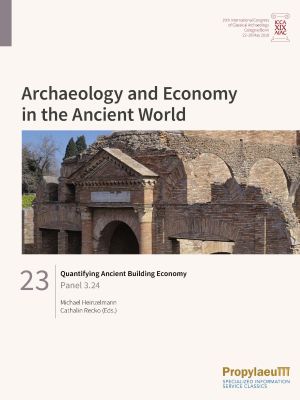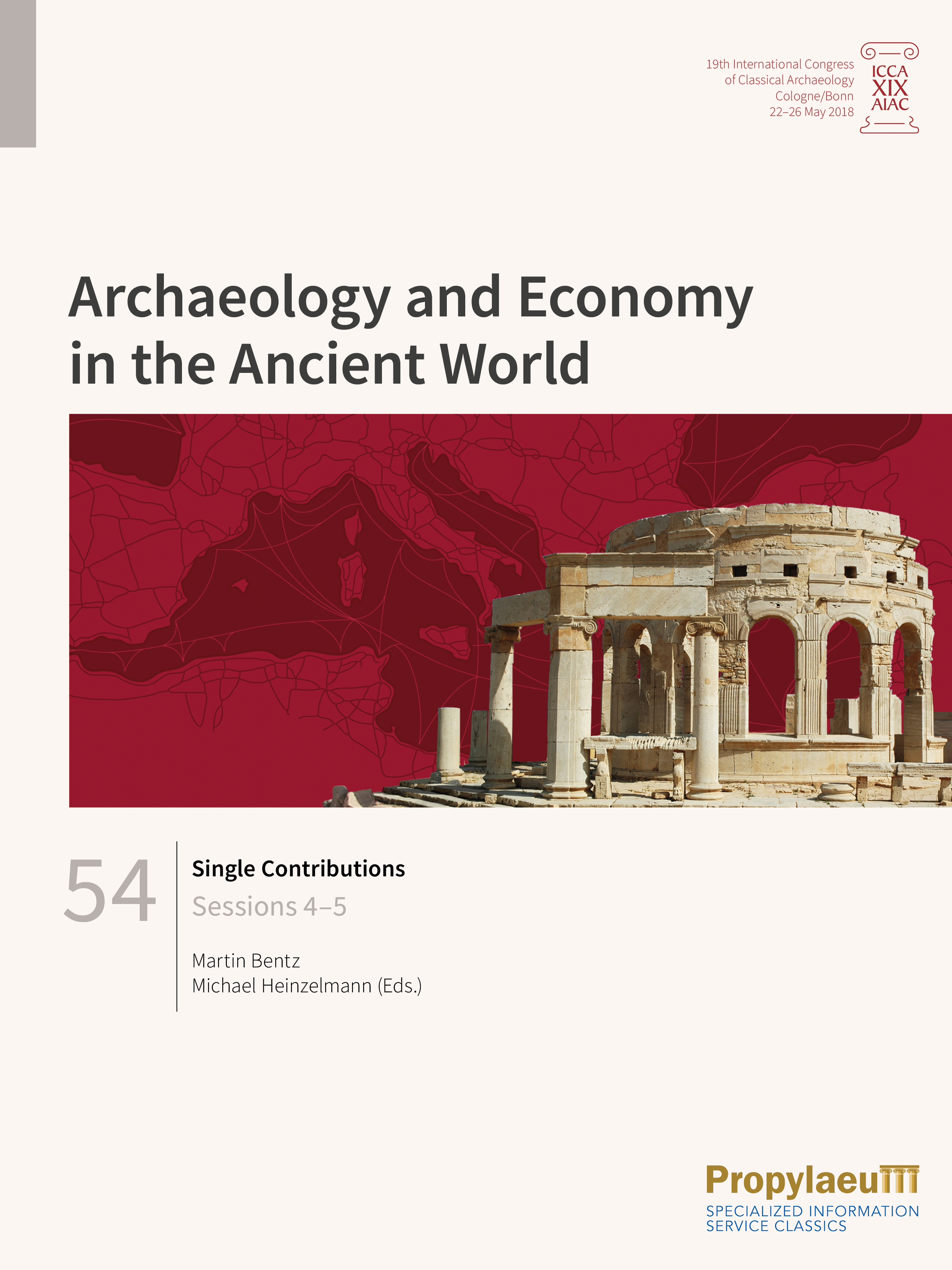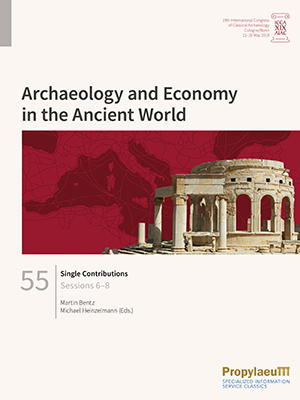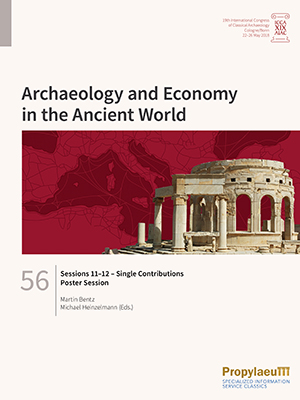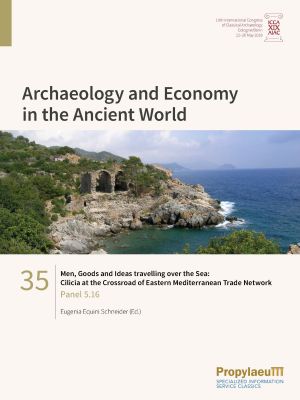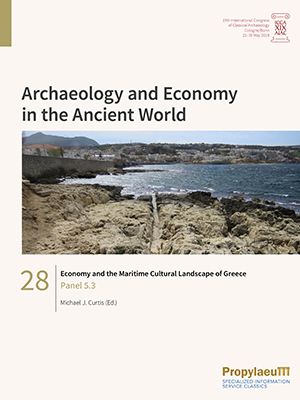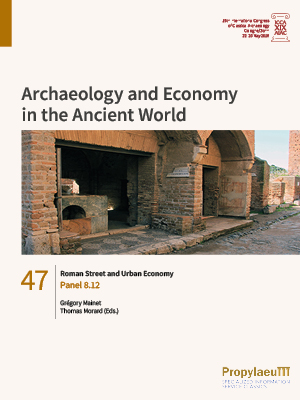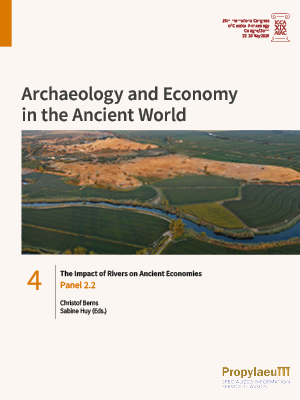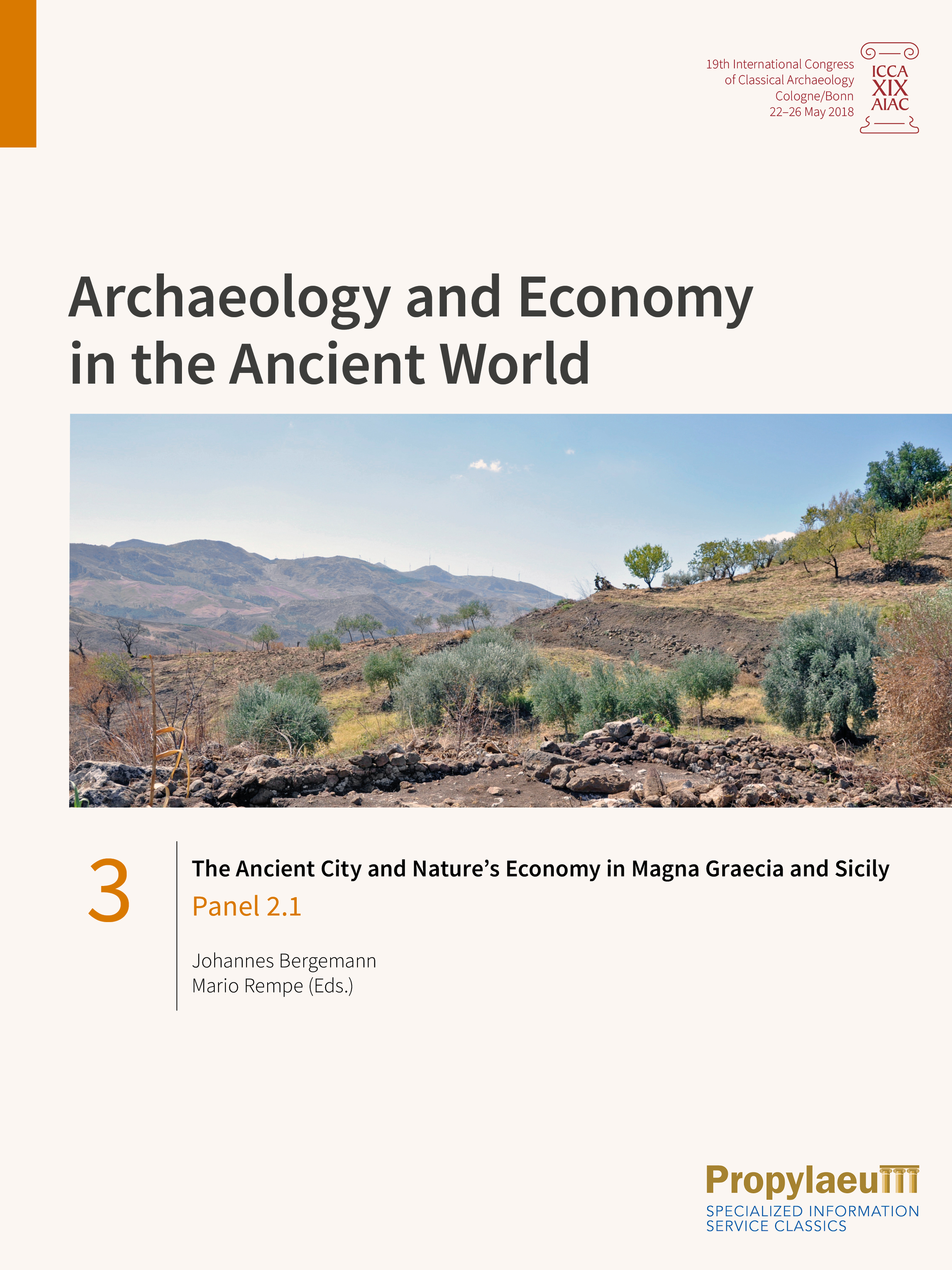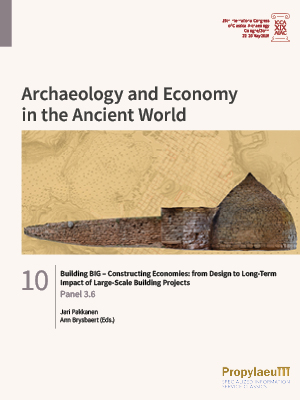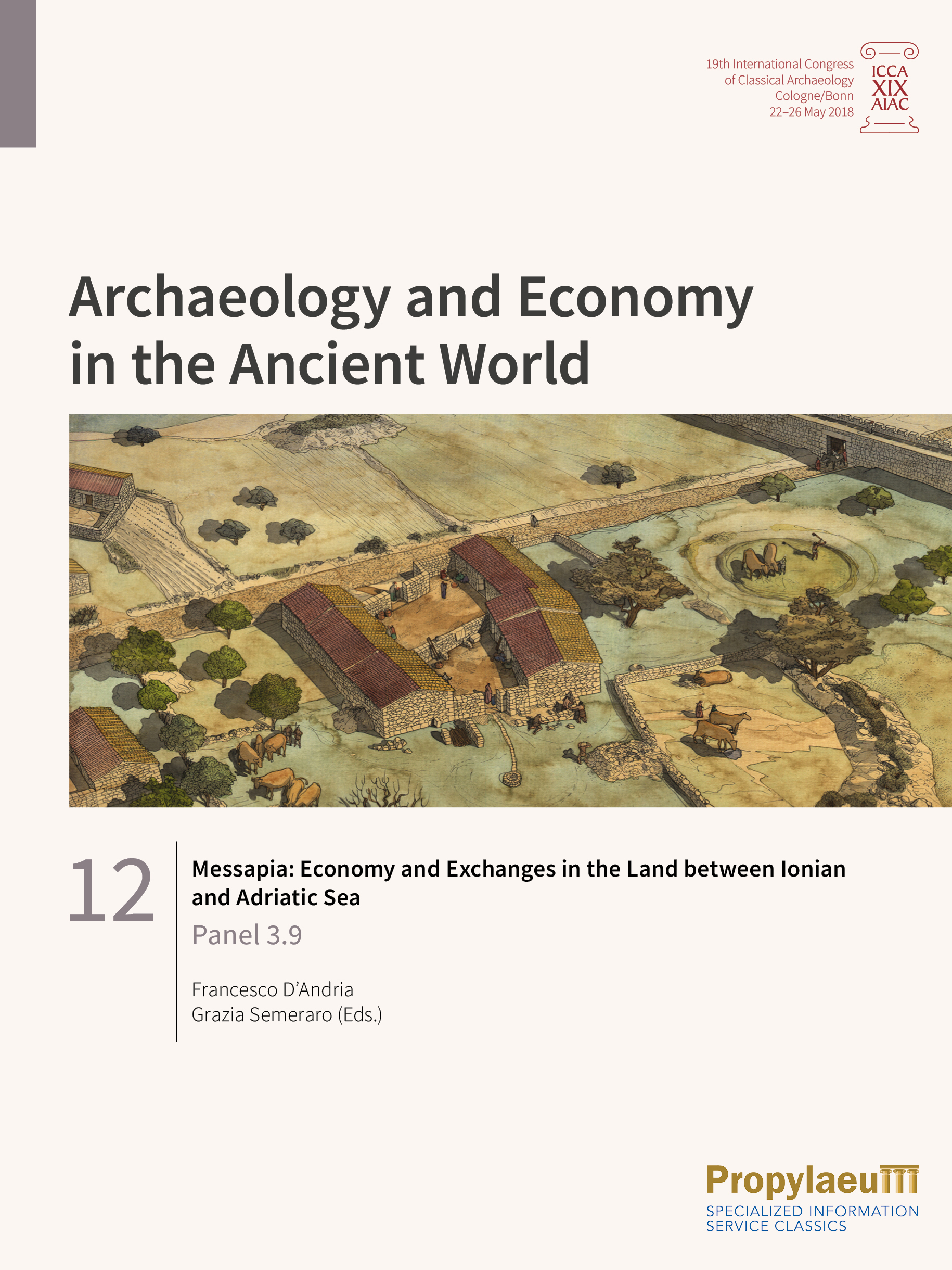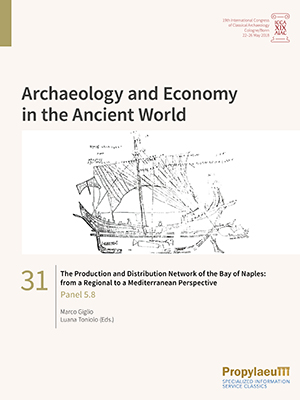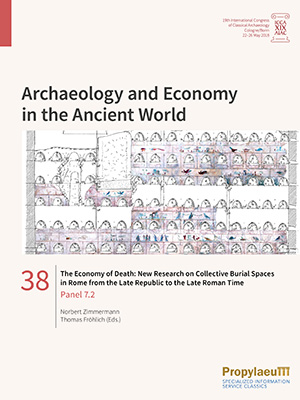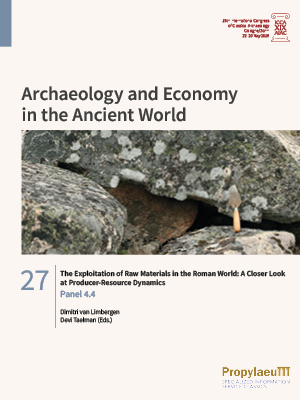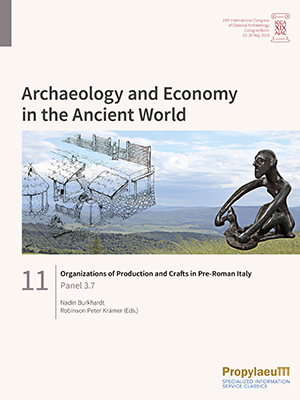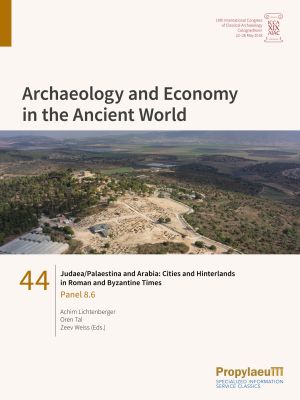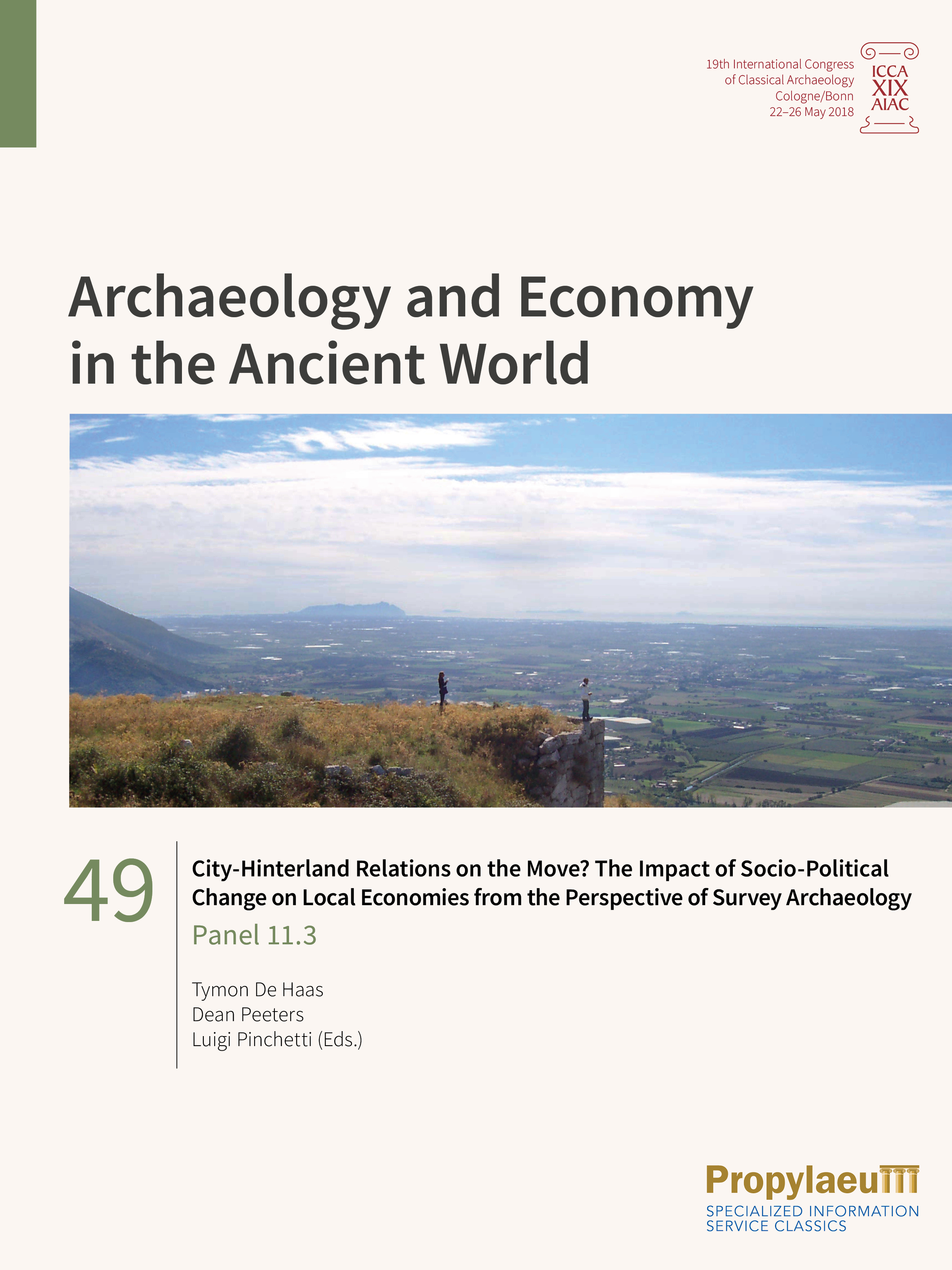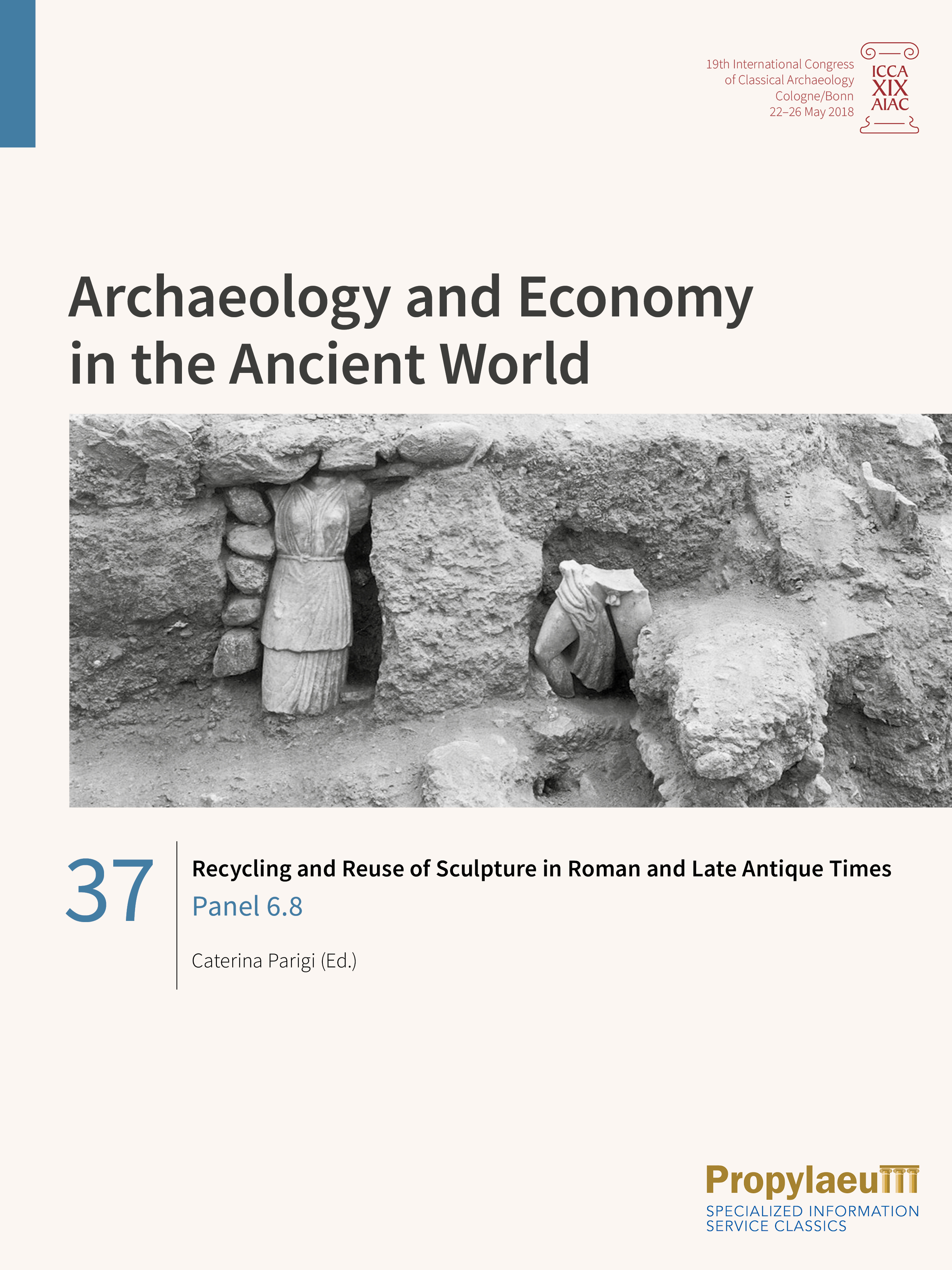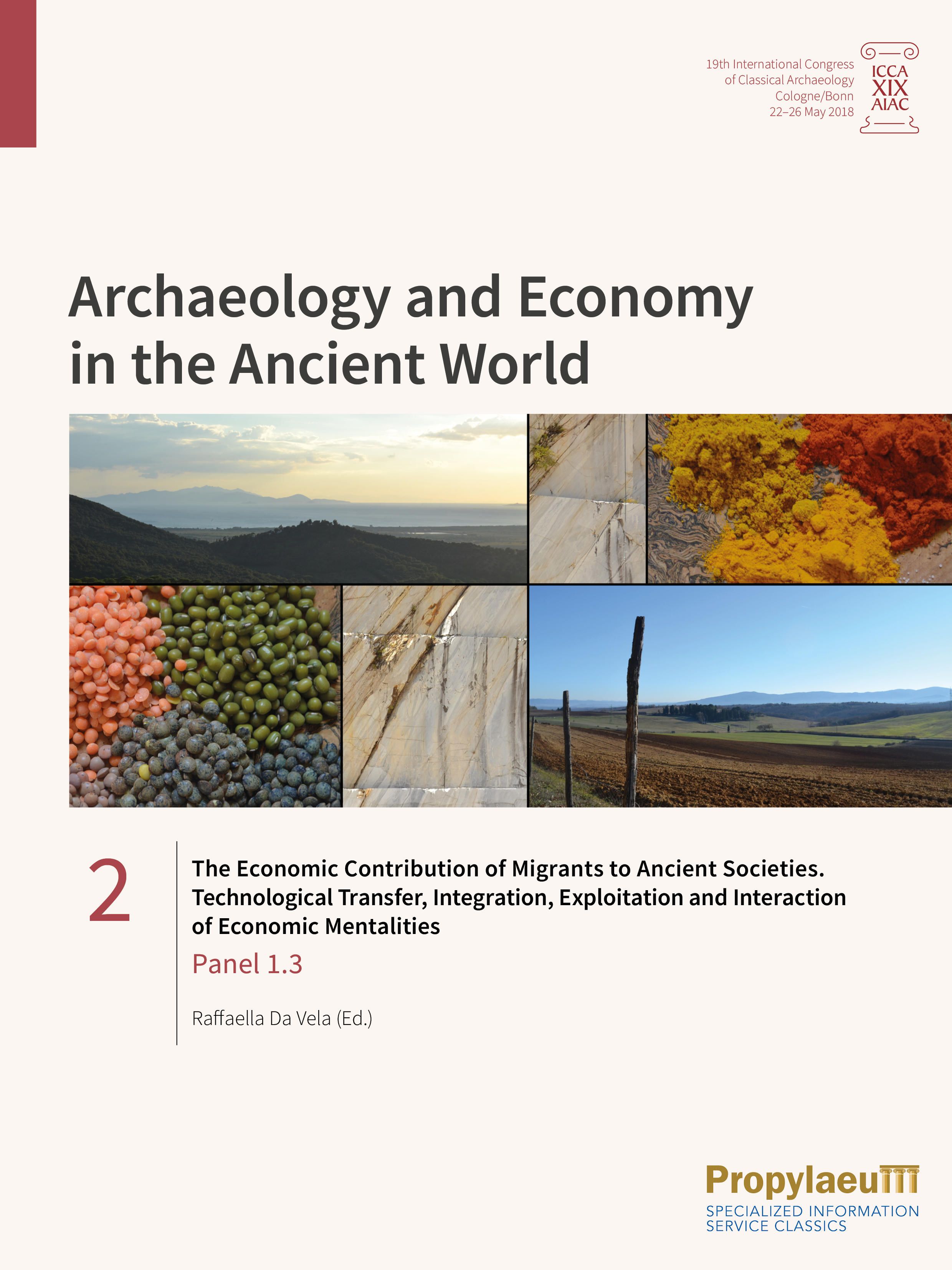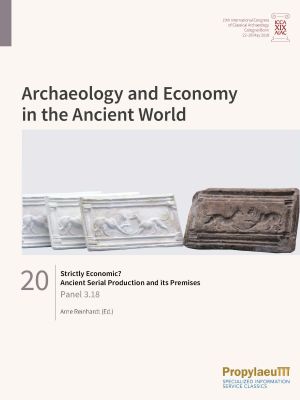Heinzelmann, Michael
Quantifying Ancient Building Economy: Panel 3.24
Die Forschung zu antiker Baugeschichte und Architektur hat sich in den letzten Jahren auf wirtschaftliche Aspekte der unterschiedlichen Bau- und Arbeitsprozesse fokussiert. In diesem Zuge können nicht nur einzelne Arbeitsschritte und Abläufe untersucht werden, sondern auch die Organisation einer Baustelle. Dafür werden Versuche unternommen, sowohl das Baumaterial als auch die benötigte Arbeitszeit zum Bau eines Gebäudes zu quantifizieren, um die Größenordnung sowie die gesamtwirtschaftlichen Auswirkungen zu erfassen.
Ziel dieses Bandes ist es, verschiedene Ansätze zur Untersuchung dieser Bauökonomie zusammenzubringen. Mit Hilfe der Methodik der Quantifizierung sowie detaillierter Studien zur Architektur werden die Bauwerke der hier gesammelten Fallstudien in Bezug auf ihre baulichen Charakteristika und die damit verbundenen wirtschaftlichen Implikationen beleuchtet. Zu diesen Bauwerken gehören Stadtmauern, Holzbauten, Thermen und Tempel. Der zeitliche Horizont der Beiträge erstreckt sich vom Messene des 4. Jh. v. Chr. bis hin zur Kaiserzeit und wird vervollständigt durch praxisorientierte Einblicke in Ingenieurshandbücher aus dem 19. Jh.
Sessions 4–5, Single Contributions
Wirtschaftliche Aspekte durchdringen alle Bereiche des öffentlichen und privaten Lebens in alten Gesellschaften, sei es in der Stadtentwicklung, der Religion, der Kunst, dem Wohnen oder dem Tod. Die Erforschung der antiken Wirtschaft spielt seit langem eine wichtige Rolle in der Alten Geschichte. In den letzten Jahrzehnten ist aber auch in der Archäologie zunehmend das Bewusstsein gewachsen, dass die materielle Kultur alter Gesellschaften ausgezeichnete Möglichkeiten bietet, die Struktur, Leistung und Dynamik alter Wirtschaftssysteme und Wirtschaftsprozesse zu untersuchen. Hauptziel dieses Kongresses war es daher, die Ökonomie als ein zentrales Element der klassischen Gesellschaften zu verstehen und ihre Wechselwirkung mit ökologischen, politischen, sozialen, religiösen und kulturellen Hintergründen zu analysieren. Das Thema des Kongresses richtete sich an alle Disziplinen, die sich mit der griechisch-römischen Zivilisation und ihren Nachbarkulturen von der ägäischen Bronzezeit bis zum Ende der Spätantike befassen.
In diesem Sammelband behandeln einzelne Beiträge der Sessions 4 und 5 Fragen zur Gewinnung von Ressourcen wie Metalle und Marmor in der römischen Kaiserzeit und auch zur Distribution, zum Handel und zu Netzwerken generell in der Antike. Thematisch reichen die Untersuchungen von Handel und Kulturkontakten im eisenzeitlichen und archaischen Mittelmeer, über griechisches und römisches Münzwesen, bis hin zu römischen Handels- und Transportsystemen.
Sessions 6–8, Single Contributions
Wirtschaftliche Aspekte durchdringen alle Bereiche des öffentlichen und privaten Lebens in alten Gesellschaften, sei es in der Stadtentwicklung, der Religion, der Kunst, dem Wohnen oder dem Tod. Die Erforschung der antiken Wirtschaft spielt seit langem eine wichtige Rolle in der Alten Geschichte. In den letzten Jahrzehnten ist aber auch in der Archäologie zunehmend das Bewusstsein gewachsen, dass die materielle Kultur alter Gesellschaften ausgezeichnete Möglichkeiten bietet, die Struktur, Leistung und Dynamik alter Wirtschaftssysteme und Wirtschaftsprozesse zu untersuchen. Hauptziel dieses Kongresses war es daher, die Ökonomie als ein zentrales Element der klassischen Gesellschaften zu verstehen und ihre Wechselwirkung mit ökologischen, politischen, sozialen, religiösen und kulturellen Hintergründen zu analysieren. Das Thema des Kongresses richtete sich an alle Disziplinen, die sich mit der griechisch-römischen Zivilisation und ihren Nachbarkulturen von der ägäischen Bronzezeit bis zum Ende der Spätantike befassen.
Dieser Sammelband beinhaltet einzelne Beiträge der Sessions 6, 7 und 8, die sich mit Fragen zu Konsum und Investitionen in Alltag, Heiligtümern und urbanen Kontexten sowie mit Fragen zur Rolle der Stadt in der antiken Wirtschaft auseinandersetzen.
Sessions 11–12, Single Contributions – Poster Sessions
Wirtschaftliche Aspekte durchdringen alle Bereiche des öffentlichen und privaten Lebens in alten Gesellschaften, sei es in der Stadtentwicklung, der Religion, der Kunst, dem Wohnen oder dem Tod. Die Erforschung der antiken Wirtschaft spielt seit langem eine wichtige Rolle in der Alten Geschichte. In den letzten Jahrzehnten ist aber auch in der Archäologie zunehmend das Bewusstsein gewachsen, dass die materielle Kultur alter Gesellschaften ausgezeichnete Möglichkeiten bietet, die Struktur, Leistung und Dynamik alter Wirtschaftssysteme und Wirtschaftsprozesse zu untersuchen. Hauptziel dieses Kongresses war es daher, die Ökonomie als ein zentrales Element der klassischen Gesellschaften zu verstehen und ihre Wechselwirkung mit ökologischen, politischen, sozialen, religiösen und kulturellen Hintergründen zu analysieren. Das Thema des Kongresses richtete sich an alle Disziplinen, die sich mit der griechisch-römischen Zivilisation und ihren Nachbarkulturen von der ägäischen Bronzezeit bis zum Ende der Spätantike befassen.
In diesem Sammelband behandeln einzelne Beiträge der Sessions 11 und 12 zum einen digitale Themen wie computergestützte Ansätze und 3D Dokumentation in Archäologie und Bauforschungen. Zum anderen beinhalten die Studien Themen zu antiken Skulpturen sowie Heiligtümern und den damit verbundenen Ritualen.
Zudem sind in diesem Band die zahlreichen verschriftlichten Poster publiziert, die während der Kongresswoche im Rahmen einer Postersession vorgestellt und diskutiert wurden.
Regional exchange of ceramics – case studies and methodology: Panel 5.7
Gefäße und andere Objekte aus Keramik stellen eine wichtige Quelle für die Rekonstruktion von Tausch und Handel in antiken Gesellschaften dar, da sie in großen Mengen verfügbar sind und ihre Herkunft oft mit archäologischen und archäometrischen Methoden bestimmt werden kann. Studien zum Handel mit Keramik konzentrieren sich jedoch zumeist auf den Fernhandel, da die Unterschiede von Waren und Formtypen zwischen Produkten aus weit auseinanderliegenden Gebieten leichter erkannt werden können. Das hat gemeinsam mit dem psychologischen Faktor, dass Gegenstände des Fernhandels oft größere Aufmerksamkeit finden, dazu geführt, dass Objekte des Fernhandels in der archäologischen Forschung eine überdimensionale Aufmerksamkeit gefunden haben, während der regionale Austausch von Gütern zwischen benachbarten Städten bisher wenig erforscht wurde, obwohl er wichtige Einblicke in die Beziehungen zwischen diesen Städten ermöglichen würde.
Einer der Gründe dafür liegt sicherlich in der Schwierigkeit, dass Keramikprodukte aus benachbarten Regionen häufig nur schwer unterschieden werden können, da sie oft dasselbe Formenrepertoire sowie Dekorationsstile aufweisen.
Dieses Panel stellt Fallstudien aus unterschiedlichen Perioden und Regionen des Mittelmeerraums vor, die sich mit der Problematik der Rekonstruktion von Netzwerken des regionalen Austausches beschäftigen, aber auch ihre Bedeutung für die Wirtschaft der antiken Städte zeigen.
Men, Goods and Ideas Travelling over the Sea. Cilicia at the Crossroad of Eastern Mediterranean Trade Network: Panel 5.16
Aufgrund seiner besonderen geographischen Lage an der Kreuzung der wichtigsten See- und Landhandelsrouten, an einem Übergangs- und Verbindungspunkt zwischen Syrien, Zypern und Ägypten, spielte Kilikien eine bedeutende Rolle im Kontext des kulturellen, sozialen und wirtschaftlichen Austauschs im Mittelmeerraum. Insbesondere während seiner Romanisierung waren die Handelsbeziehungen zu den verschiedenen Gebieten des Reiches, insbesondere zum östlichen Mittelmeerraum, von grundlegender Bedeutung, die bis in frühbyzantinische Zeit substantiell und dauerhaft unterhalten wurden. Gegenstand dieses Panels war eine Übersicht zum Forschungsstand über diese Region, mit einem Schwerpunkt auf interdisziplinären Studien zu Produktionsaustausch, Handel und Verkehr im Mittelmeerraum. Die Unterwasserforschung, archäologische und geophysikalische Untersuchungen von Hafenbecken, Untersuchungen zu Produktionsanlagen und Analysen der materiellen Kultur und der numismatischen Zeugnisse haben zu einem umfangreichen Panorama der Veränderungen und Transformationsprozesse geführt, die die Region und ihre städtischen Zentren im Laufe der Jahrhunderte als Ergebnis großer sozialer und wirtschaftlicher Prozesse betroffen haben. Die daraus resultierende Fülle von Informationen über die Rolle der Region als Produktionszentrum und Umschlagplatz hat komparative Beispiele für andere Forschungsarbeiten in Kilikien und der südöstlichen Türkei erbracht.
Economy and the Maritime Cultural Landscape of Greece: Panel 5.3
In den letzten Jahren haben neue Forschungen und Untersuchungen entlang der Küstenlinien zu unserem Verständnis der maritimen Kulturen und Traditionen des antiken Griechenlands beigetragen. Dennoch sind die maritimen Kulturen, Traditionen und sozialen Aspekte nach wie vor wenig erforscht, und die traditionellen Grenzen zwischen Land- und Unterwasserarchäologie sind nach wie vor problematisch und eine Herausforderung für die Forscher. Im Laufe der Zeit wurden die Siedlungen am Meer für die lokale und regionale Wirtschaft immer wichtiger, da sie oft vom lokalen, inselinternen und intermediterranen Handel und den sich daraus ergebenden Handels- und Vernetzungsmöglichkeiten profitierten. Viele dieser Siedlungen waren die erste Anlaufstelle für Seeleute, Reisende und Migranten und spielten eine wichtige Rolle bei der Verbreitung kultureller, politischer und religiöser Ideologien.
Die Beiträge in diesem Band nehmen uns mit auf eine Zeitreise von einer frühbronzezeitlichen Siedlung auf Paros über die geschlossenen Häfen des archaischen und klassischen Griechenlands bis hin zum Leben im hellenistischen und römischen Kreta. Die Beiträge in diesem Band sind zwar nur vorläufige Perspektiven, zeigen aber die breite Vielfalt des Themenmaterials und bieten einen interessanten Einblick in die Welt des maritimen Griechenlands.
Roman Street and Urban Economy: Panel 8.12
Straßen spielten eine Schlüsselrolle bei der Gestaltung des antiken wirtschaftlichen Stadtbildes. Normalerweise betrachten wir Straßen lediglich als Durchgangswege für den Verkehr, aber diese Idee entspricht nicht den Tatsachen, wie sie von antiken Autoren wie Martial oder Juvenal beleuchtet wurden. Der "Straßenraum" wurde in drei Dimensionen angelegt und war ein wichtiger Ort für die sozialen und wirtschaftlichen Interaktionen, die das städtische Sozialleben in der Antike ausmachten. Eine solche Funktion zeigt sich deutlich in der Architektur der Straße, die durch zahlreiche tabernae, die in Atriumhäusern, Ladenzeilen oder mehrstöckigen Gebäuden errichtet wurden, und durch die Aktivitäten, die sich dort abspielten. Mit anderen Worten, die Wirtschaft der antiken Städte beschränkte sich nicht auf bestimmte Gebäude wie etwa die macella. Im Gegenteil, die wirtschaftlichen Aktivitäten erstreckten sich über die Mauern solcher Gebäude hinaus und drangen entlang der Straßen in das gesamte Stadtgefüge ein. Die Beiträge des Panels "Antike Straßen und städtische Wirtschaft" wollen ein neues Licht auf die Rolle des Straßenraums in der städtischen Wirtschaft der antiken Gesellschaften werfen, zeitlich fokussiert auf den Zeitraum zwischen dem 2. Jahrhundert v. Chr. und dem 3. Jh. n. Chr. Um unser Verständnis zu vertiefen, unter suchen die verschiedenen Autoren einige Fallstudien z.B. aus Alba Fucens, Athen, Lugdunum, Norba, Ostia und Pompeji.
The Impact of Rivers on Ancient Economies: Panel 2.2
Das gewachsene Forschungsinteresse an den Verflechtungen von soziokulturellen und physischen Räumen hat u. a. dazu geführt, Wasserläufe als gestaltende Faktoren von Gesellschaften und ihren Wirtschaftssystemen wahrzunehmen. Flusslandschaften weisen spezifische Bedingungen auf, die das Leben von Menschen vielfach beeinflusst haben. Flüsse bieten als natürliche Ressourcen besondere Möglichkeiten für wirtschaftliche Aktivitäten. Sie können beispielsweise sowohl als Verbindungsadern als auch als Grenzlinien fungieren. Die Beiträge unseres Panels beschreiben Flüsse als dynamische Faktoren antiker Lebenswelten. Die Aufsätze dieses Bandes konzentrieren sich auf die Wechselbeziehung zwischen Flusslandschaften und den wirtschaftlichen Gewohnheiten ihrer Bewohner. Die Fallstudien decken ein breites zeitliches wie geographisches Spektrum ab und diskutieren Phänomene wie geomorphe und anthropogene Veränderungen von Flüssen, die Rolle von Flüssen als Transport- und Handelswege und ihre Auswirkungen auf Siedlungsmuster.
The Ancient City and Nature's Economy in Magna Graecia and Sicily: Panel 2.1
Im Rahmen der Veranstaltung wurden archäologische Landschaftsstudien und paläoökologische Rekonstruktionen vorgestellt und auf diese Weise die Wechselwirkungen zwischen Mensch und Umwelt beleuchtet. Die Verbindung von Archäologie und Geowissenschaften machte an mehreren Orten in Magna Graecia und Sizilien verschiedene Muster dieser Wechselwirkungen sichtbar.
Die Ansätze kombinierten archäologische Methoden mit Geoarchäologie, Palynologie, Archäozoologie und Klimageschichte. Die Fallstudien erstreckten sich über einen langen Zeitraum und reichten bis in die frühen Phasen der griechischen Besiedlung Siziliens zurück. Darüber hinaus wurden Verschiebungen in der Siedlungsdynamik zwischen römischer und griechischer Zeit beobachtet und Hypothesen aus einer paläoökologischen Perspektive aufgestellt. Gleichzeitig wurden die wirtschaftlichen und sozialen Implikationen und ihre Auswirkungen auf die Daten untersucht. Die Beispiele stammten sowohl aus der Surveyarchäologie als auch aus bei Ausgrabungen gewonnenen Proben.
Building BIG – Constructing Economies: from Design to Long-Term Impact of Large-Scale Building Projects: Panel 3.6
Dieser Band enthält verschiedene Studien, die von prähistorischen griechischen Bauprogrammen bis zum Bauen in der römischen Zeit reichen. Das Wirtschaftswachstum moderner Gesellschaften ist eng mit der Bauwirtschaft verknüpft: Investitionen, Transportinfrastrukturen für Materialien und arbeitsintensive Bauprogramme haben alle einen großen Einfluss auf die lokale, regionale und sogar globale Wirtschaft. Die Ergebnisse haben die gebaute Umwelt unseres Alltagslebens geprägt und oft zu mehr Lebensqualität und Wohlstand geführt, obwohl es viele Fälle gibt, die auch das Gegenteil bewirkt haben. Groß angelegte Bauprojekte in vorindustriellen Gesellschaften erforderten vom Zeitpunkt der Materialsuche über die Gewinnung, den Transport, die Nutzung und die anschließende Instandhaltung umfangreiche Handarbeit. Da die meisten vorindustriellen Gesellschaften auf Subsistenzwirtschaft basierten, waren wichtige Entscheidungen ein täglicher Balanceakt zwischen Bauarbeiten und Landwirtschaft. Diese Entscheidungen hatten oft einen starken Einfluss auf die Muster der Landnutzung und können auch zu zirkulären Wirtschaftsstrategien geführt haben. Die in diesem Band vorgestellten Beiträge betonen die Bedeutung der sozioökonomischen und politischen Strukturen und Entscheidungen, die zum "Building Big" führten, unabhängig von der Form und der endgültigen Größe der Projekte.
The Rural Foundations of The Roman Economy. New Approaches to Rome’s Ancient Countryside from the Archaic to the Early Imperial Period: Panel 11.1
Ziel der AIAC-Sitzung 2018 "Die ländlichen Grundlagen der römischen Wirtschaft, neue Ansätze für Roms antike Landschaft von der archaischen Periode bis zur frühen Kaiserzeit" war es, methodisch fundierte, datengestützte Studien zusammenzuführen, um die Triebkräfte und die Leistung der ländlichen Wirtschaft Mittelitaliens von der archaischen Periode bis in die römische Kaiserzeit zu beleuchten. Das Ergebnis der Sitzung war eine kohärente Sammlung von Beiträgen eines breiten Spektrums internationaler Wissenschaftler des Gebietes, die sich der römischen Landwirtschaft aus verschiedenen disziplinären Blickwinkeln und in unterschiedlichen Maßstäben nähern. Der Schwerpunkt der Sammlung liegt auf dem suburbium von Rom sensu lato. Die Themen reichen von der Verteilung ländlicher Siedlungen über wirtschaftliche und demographische Modelle bis hin zur Analyse von der Analyse keramischer Surveyfunde und der Untersuchung von Pollen- und Pflanzenmakroresten.
Messapia: Economy and Exchanges in the Land between Ionian and Adriatic Sea: Panel 3.9
Seit der Bronzezeit hat die geographische Lage Messapiens zwischen dem ionischen und dem adriatischen Meer die Entwicklung von Beziehungen ermöglicht, die sich durch Kontinuität im Rahmen der Mobilität im Mittelmeer auszeichnen. Dieser Band konzentriert sich auf bestimmte Aspekte der Wirtschaft in Messapien, insbesondere auf bioarchäologische Themen (einschließlich der Viehzucht und des Verbrauchs tierischer Ressourcen), die Textilproduktion (die mit Hilfe archäometrischer Methoden Stoffreste analysiert) und die Einfuhr von Luxusprodukten aus griechischen Städten und den griechischen Kolonien Süditaliens. Das Vorhandensein von importierten Prestigegegenständen in Grabbeigaben wurde in Bezug auf die Formen der Selbstdarstellung des messapischen Adels sowohl bei Begräbnisritualen als auch bei Machtdemonstrationen innerhalb der Siedlungen untersucht. Die Vielfalt der religiösen Ausdrucksformen in der Welt Messapiens stellt eine besondere Fallstudie dar, die mit dem Kulturaustausch verbunden ist und die dank der jüngsten Entdeckungen von Kultstätten nun im Detail untersucht werden kann. Wichtig in diesem Zusammenhang sind die Entdeckungen in Castro, wo das Athenaion - verbunden mit dem Mythos von der ersten Landung Äneas' an den Küsten Italiens - identifiziert wurde.
The Production and Distribution Network of the Bay of Naples: from a Regional to a Mediterranean Perspective: Panel 5.8
Jüngste Ausgrabungen an Produktions- und Verbrauchsstätten in Kampanien und internationale Konferenzen zur römischen Keramik haben der Forschung zur materiellen Kultur und zu den regionalen und internationalen Keramikhandelssystemen neue Impulse gegeben.
Der Band analysiert die Verbreitung der im Golf von Neapel produzierten Keramik von der spätrepublikanischen Periode bis in die frühen Kaiserzeit aus einer doppelten Perspektive: auf der einen Seite die Netzwerke, die die Keramik aus dem Golf zu verschiedenen Punkten entlang der Mittelmeerküste transportierten, und auf der anderen Seite die Lebensmittel, die von verschiedenen Punkten des Mittelmeers nach Neapel kamen.
Die Ausgrabungskontexte der Piazza Municipio in Neapel, Puteoli und Herculaneum liefern sowohl in qualitativer als auch in quantitativer Hinsicht neue relevante Datensätze. Diese Belege verdeutlichen die engen Beziehungen dieses Gebietes mit dem östlichen Mittelmeerraum, insbesondere bei feinen Waren und Transportbehältern - von den rhodischen Weinamphoren aus dem 2. Jahrhundert v. Chr. bis zu kretischen Produkten aus dem 1. Jahrhundert n. Chr.'Das Gebiet des Magdalensbergs importierte bereits in spätrepublikanischer Zeit und in der augusteischen Epoche in besonders hohen Mengen kampanische Red Slip ware, ein Zeit, in der kampanische Kochwaren auch in Aquileia in Norditalien bezeugt sind, dem Hotspot für die Verbreitung dieser Gefäße in die Provinzen Nordeuropas.
The Economy of Death: New Research on Collective Burial Spaces in Rome from the Late Republic to the Late Roman Time: Panel 7.2
Die Beiträge dieses Bandes diskutieren wirtschaftliche Aspekte römischer Grabanlagen, die für eine größere Anzahl von Bestattungen ausgelegt sind, also etwa Kolumbarien, große Hypogäen oder Katakomben. Zugleich wird nach den Besitzern und Nutzern gefragt. Es wird untersucht, inwieweit wirtschaftliche Gründe bei der Erfindung, der Entwicklung und der Nutzung der großen Grabmonumente in Rom eine Rolle spielten und wie diese Bauten die religiösen und sozialen Bedürfnisse ihrer Auftraggeber bzw. der Bestatteten erfüllten, insbesondere in der Zeit des Übergangs von der römischen zur frühchristlichen Zeit. Jüngste Detailstudien zu den römischen Grabbauten lassen interessante Spuren des dynamischen Prozesses der Vorbereitung und Nutzung des Grabraumes dokumentieren, und speziell bei größeren Grabanlagen für weit mehr als eine einzige Familie ist der wirtschaftliche Aspekt von Besitz und Nutzung vielversprechend. Wer plante ein Bauvorhaben, wie und warum wurden ein bestimmter Ort und eine spezifische Architektur gewählt? Wie und wo im ursprünglichen Grabbau sah der Eigentümer für sich und seine Familie den eigenen Bestattungsplatz vor, und wo und auf welche Art und Weise wurden weitere Gräber verkauft oder sogar verschenkt? In den letzten Jahrzehnten mussten sich eine Reihe allgemeiner Studien zu römischen Bestattungen und Bestattungsbräuchen notwendigerweise auf ältere Dokumentationen stützen, während neue und detailliertere Analysen einzelner Monumente oft neue Erkenntnisse liefern und neue Interpretationen nahelegen.
Politics of Value: New Approaches to Early Money and the State: Panel 5.11
Als eine der beständigsten Ikonen des Wirtschaftslebens war Geld von der Antike bis zur Gegenwart ein gemeinsames Merkmal und ein zentraler Fokuspunkt in komplexen Gesellschaften. Im Laufe des ersten Jahrtausends v. Chr. gewann es als wesentliches Merkmal der Volkswirtschaften des Mittelmeerraums an Gewicht, meist in Form von Münzen. Aber Geld ist mehr als nur eine Münze, und seine Bedeutung ist nicht nur im engeren Feld der "Wirtschaft" allgegenwärtig.
Im antiken Mittelmeerraum waren Geld und sein Bedeutungsgewinn überwiegend mit dem Staat assoziiert. Aber kann Geld nur unter staatlicher Autorität entstehen? Der vorliegende Band hinterfragt den vermuteten Zusammenhang zwischen der Verbreitung früher Geldformen und dem Staat und macht auf verschiedene Möglichkeiten aufmerksam, wie Geld als Innovation verankert und gesellschaftlich eingebettet werden konnte.
The Exploitation of Raw Materials in the Roman World: A Closer Look at Producer-Resource Dynamics: Panel 4.4
Im Vergleich zu anderen vormodernen Volkswirtschaften zeichnet sich die römische Welt durch die Entwicklung eines hochspezialisierten und sehr produktiven Produktionssektor aus. Diese Entwicklung führte zur grossflächigen Ausbeutung von Rohstoffen. Sogar in einem Gebiet von der Grösse des römischen Reiches übten diese Aktivitäten großen Druck auf die Natur aus. Strategien der Ressourcennutzung und -erhaltung waren daher unerlässlich, um mit der mittel- oder langfristigen begrenzten Verfügbarkeit dieser Ressourcen erfolgreich umzugehen und die Nachhaltigkeit des römischen Nutzungsmodells zu sichern. Dieser Band befasst sich mit den verschiedenen Arten der Ausbeutung und Bewirtschaftung natürlicher Ressourcen in der römischen Welt. Er konzentriert sich darauf, ob, wann, wo und wie die Römer ein harmonisches Gleichgewicht zwischen der begrenzten Verfügbarkeit einer bestimmten Ressource und dem Gesetz von Angebot und Nachfrage anstrebten. Die Fallstudien in diesem Band decken verschiedene Schlüsselbereiche der weströmischen Welt ab - von Italien und der Insel Elba, über das Küstenland Kroatien bis hin zu Zentral-Ost-Gallien und dem pannonischen Limes - und diskutieren insbesondere die Fischindustrie, die Eisenverhüttung, die Abholzung und Waldbewirtschaftung, den Steinhandel und die Ausbeutung thermomineralischer Ressourcen.
Organizations of Production and Crafts in Pre-Roman Italy: Panel 3.7
Während wirtschaftliche Fragestellungen und Ansätze in den Klassischen Altertumswissenschaften immer wichtiger werden, ist das für Forschungen zum ‚vorrömischen Italien‘, der italienischen Halbinsel, Sizilien und Sardinien in der Eisenzeit, nicht unbedingt der Fall. Bis vor Kurzem gab es so gut wie keine ökonomischen Studien zum ‚vorrömischen Italien‘ mit wenigen Ausnahmen, die sich auf sehr spezielle Bereiche fokussierten:
(1) die Spezialisierung von Handwerk und Produktionen im Kontext von Urbanisierungsprozessen; (2) spezifische Produktionsbereiche, wie etwa die Landwirtschaft, Metallverarbeitung und Salzgewinnung; (3) Studien zu griechischen Kolonien und Kontakten zwischen Griechen und ‚indigenen Bevölkerungen‘; (4) Analysen von Konsumverhalten, insbesondere der Konsum von griechischer Keramik.
Jedoch haben rezente Ausgrabungen und Untersuchungen von Werkstätten, etwa in Gabii, Pithekoussai, Kroton, Lokroi Epizephyrioi, Naxos, Selinunt und Kyme/Cumae, eine Fülle neuer Daten ergeben, die zu einer fruchtbaren und ergiebigen Diskussion von Organisationsformen bei Produktionen und Handwerk im ‚vorrömischen Italien‘ anregen.
Aus diesem Anlass haben vier Mitglieder der Arbeitsgemeinschaft Etrusker und Italiker des DArV e.V. in diesem Panel wirtschaftliche Aspekte des ‚vorrömischen Italien‘ auf der Grundlage ihrer aktuellen Forschungsprojekte diskutiert. Der Fokus liegt bei allen Beiträgen im Bereich der Produktion und des Handwerks. Ziel des Bandes ist es, anhand einer Diskussion aktueller Fallstudien und Methoden zu einer Debatte über mögliche geographische, chronologische und funktionale Muster in der Organisation von Handwerk und Produktionen beizutragen.
Judaea/Palaestina and Arabia: Cities and Hinterlands in Roman and Byzantine Times: Panel 8.6
Seit mehreren Jahrzehnten steht die Survey-Archäologie und die Untersuchung von Stadt-Hinterland-Beziehungen im Fokus der mediterranen Archäologie. In der südlichen Levante wurden diese Ansätze bisher jedoch nur selten verfolgt. So wurden nur wenige Städte dieser Region durch systematische intensive oder extensive Surveys untersucht. Dieser Band ist der städtischen Infrastruktur gewidmet und konzentriert sich auf die Untersuchung der Beziehungen zwischen Städten und ihrem Hinterland. Hierbei fokussiert er sich auf Haupt- und Nebenverwaltungszentren in Judäa / Palästina und Arabien unter römischer und byzantinischer Herrschaft (1. bis 7. Jh. n. Chr.). Während die Erforschung der historischen Geographie der südlichen Levante eine lange Tradition hat, haben sich heutzutage die Forschungsfragen gewandelt und die Erforschung von Mikroregionen und ihres Hinterlandes steht nun in vielen Fällen im Mittelpunkt der Projekte. Solche Studien können nur systematisch durchgeführt werden, wobei multidisziplinäre Ansätze und hochauflösende Analysen verwendet werden, um alle Arten von Zonen städtischer Siedlungen und Verbindungen innerhalb des Standorts und seiner Peripherie und seines Hinterlandes zu untersuchen. Die Beiträge dieses Bandes bieten einen ersten Versuch, die städtischen Siedlungen in der südlichen Levante aus einer vergleichenden Perspektive zu betrachten.
The Production of Military Equipment – Fabricae, Private Production and More: Panel 9.1
Die Herstellung militärischer Ausrüstung ist ein viel komplizierteres Thema als oft angenommen, da römische Soldaten vom Staat nicht vollständig und einheitlich ausgerüstet wurden. Während ein gewisses Maß an "Beinahe-Uniformität" in der Armee notwendig war, war eine vollständige Uniformität logistisch unmöglich, selbst innerhalb derselben Einheit. Ein Grund hierfür war, dass römische Soldaten den größten Teil der Ausrüstung selbst besaßen, was ihnen erlaubte, (innerhalb gewisser Grenzen) ihre eigene Wahl zu treffen.
Nach einer Einführung und einem Überblick über das Thema gehen die drei Fallstudien den Fragen nach, was die in einem Kastell gefundenen Werkzeuge über die Produktion von militärischem Gerät am Ort aussagen können, welchen Einfluss Werkstatttraditionen auf die Herstellung von Kettenhemden hatten und ob bei der Herstellung von Armbrustfibeln die staatliche Kontrolle oder die lokale Produktion den Ausschlag gegeben hat.
Trade in Ancient Sardinia: Panel 5.4
Die Themen dieses Panels sind die Handelsrouten des antiken Sardinien. Welches sind die Handelswege, die das antike Sardinien tangieren? Welche Gebiete und Städte Sardiniens sind am stärksten in diesen Handel involviert? Welche Produkte werden ausgetauscht und wie wurde die Produktion der Insel durch den Handel beeinflusst? Welche Muster sind bei der Einfuhr und Nachahmung ausländischer Waren zu beobachten, und welche Produkte wurden von Händlern auf die Insel gebracht? Wie verändern sich diese Aspekte im Laufe der Zeit, von der Archaik bis zur Spätantike?
Diese Analyse des antiken Handels in Sardinien wird vorwiegend auf der Grundlage von Töpfereikontexten durchgeführt. Aber natürlich werden auch andere Handelsgüter berücksichtigt, wie z. B. Eisenerz, von denen Sardinien große Mengen besaß und das dadurch die Handelswege ab dem ersten Jahrtausend v. Chr. prägte. Die untersuchten chronologischen Phasen reichen von der Archaik bis in die Spätantike und umfassen Transaktionen von Ureinwohnern, Karthagern und Griechen, unter besonderer Berücksichtigung des Handels in der römischen Ära.
City-Hinterland Relations on the Move? The Impact of Socio-Political Change on Local Economies from the Perspective of Survey Archaeology: Panel 11.3
Während die Auswirkungen großer gesellschaftlicher Veränderungen auf Stadt und Land schon immer ein zentrales Thema in der Survey-Archäologie waren, bieten die jüngsten methodologischen und theoretischen Fortschritte neue Perspektiven auf dieses Thema. Zunehmend intensivere Feldbegehungstechniken, Sammlungsstrategien für Artefakte und sowohl typologische als auch technologische Artefaktstudien haben unser Verständnis von ländlichen Siedlungen und dem Konsum von keramischen Produkten, insbesondere von lokalen (Grob-)Waren, verändert. Diese Entwicklungen ermöglichen es uns, Veränderungen in den lokalen Produktions- und Austauschsystemen in viel größerer räumlicher und zeitlicher Detailgenauigkeit zu untersuchen, und tragen wiederum zu einer Überprüfung der Auswirkungen bei, die großräumige Transformationen auf lokale Siedlungssysteme und Volkswirtschaften hatten.
Recycling and Reuse of Sculpture in Roman and Late Antique Times: Panel 6.8
Die Wiederverwendung von Skulpturen war eine typische Praxis in der Antike und wurde in unterschiedlicher Art und Weise in mehreren Orten und Zeiten ausgeübt.
Der Band konzentriert sich auf zwei Aspekte dieses Phänomens: Auf der einen Seite wurden Skulpturen und ihre Teile als Baumaterial wiederverwendet. Auf der anderen Seite behielten die Skulpturen ihre Funktion bei und wurden als Kunstwerke wiederverwendet.
Die Praxis bringt mit sich eine Reihe von Konsequenzen in Zusammenhang mit dem sozio-ökonomischen Aspekt. Eine große Rolle für die Wiederverwendung spielt der Wirtschaftsfaktor, deswegen muss steht berücksichtigt werden; sowie die Schwierigkeit in der Spätantike neue angefertigten Skulpturen zu beschaffen. Die Wiederverwendung ist aber eine komplexe Praxis, die nicht nur auf die spätantike Zeit beschränkt ist und dessen Beweggründe vielseitiger sind. Die Wiederverwendung von Skulpturen als Baumaterial kann manchmal ästhetische Gründe haben und zeigt einen deutlichen Verweis auf älteren Epochen.
Der Band fokussiert auf die römische und spätantike Zeit. Ziel ist es, die Kontinuität und die Komplexität des Phänomens zu zeigen. Durch die Diskussion und den Vergleich mehrerer Fallstudien aus unterschiedlichen Kontexten werden Ähnlichkeiten und lokalen Besonderheiten hervorgehoben.
The The Economic Contribution of Migrants to Ancient Societies. Technological Transfer, Integration, Exploitation and Interaction of Economic Mentalities: Panel 1.3
Archäologische Studien zu Migranten konzentrieren sich in der Regel auf ihre Rolle in Produktionsaktivitäten, entweder als Teil der Erwerbsbevölkerung oder als spezialisierte Handwerker, die von lokalen Unternehmern, Familien oder öffentlichen Institutionen abhängig sind. Dieses Buch zielt darauf ab, diesen einseitigen Diskurs über die Abhängigkeit von Migranten zu überwinden und einen alternativen Ansatz vorzuschlagen, indem es Migranten als Akteure im Wirtschaftsleben antiker Gesellschaften untersucht. Die wirtschaftliche Dimension der Migration wird somit als Teil der komplexen Dynamik von Integration und Segregation in lokalen Gemeinschaften analysiert. Migranten werden als Konsumenten, Kulturvermittler, soziale Aufsteiger, Vermittler anderer Lebensstile und als "Auslöser" für Innovationen betrachtet. Die Beiträge in diesem Band schlagen neue Methoden und Interpretationswege vor und behandeln ein breites Spektrum von Fallstudien vom mittleren Reich Ägyptens bis zur Bronze- und Eisenzeit des westlichen Mittelmeerraums, vom klassischen Griechenland bis zum hellenistischen Etrurien und schließen mit der Przeworsker Kultur Pannoniens. Unter Überwindung der binären Gegensätze, die gewöhnlich zwischen Kolonisten und indigenen Völkern, Einheimischen und ‘Eingeschmeckten’ aufgebaut werden, zeigt dieses Buch auf, wie wirtschaftliche Mentalitäten Teil einer größeren Verstrickung persönlicher, sozialer und wirtschaftlicher Identitäten sind.
Strictly Economic? Ancient Serial Production and its Premises: Panel 3.18
Das vielschichtige Themenfeld von Produktion und Konsum in der Antike stößt seit geraumer Zeit auf ein wachsendes Interesse in der Klassischen Archäologie. Forschungen mit ökonomischer Perspektive wie etwa die Untersuchung von Dynamiken der antiken Objekt- oder Ornamentproduktion haben dabei neue Einblicke in die griechisch-römische Kultur eröffnet. Vor diesem Hintergrund thematisiert der vorliegende Band eine bestimmte Fertigungsweise: die Produktion in Serie. Auf der Grundlage nahsichtiger Betrachtungen am Befund beleuchten die Autorinnen und Autoren des Bandes exemplarisch das breite Spektrum antiker Serienfertigung in Griechenland und Rom; die behandelten Beispiele reichen von (spät-)klassischer Keramik mit gemaltem Dekor über mechanisch reproduzierte Münzen und Reliefgeschirr bis zu luxuriösen Marmorurnen. Ziel ist einerseits die Beschreibung einzelner Serien und ihre Abgrenzung sowie andererseits, darauf aufbauend, die Interpretation der jeweiligen Voraussetzungen. Hierbei zeigt sich, dass das Phänomen der Serienfertigung (und Serialität) wiederholt über wirtschaftliche Aspekte hinausweist und nahtlos in andere Bereiche der antiken Kulturgeschichte und ihrer Erforschung überleitet.



